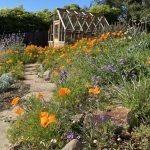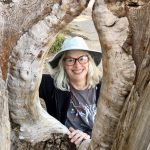
Michelle Orr, pictured while perfecting her sourdough during shelter-in-place.
Environmental engineer Michelle Orr’s life has been interwoven with the San Francisco Bay since childhood. “I grew up in Oakland with a view of the bay, and we went sailing and to the Emeryville mudflats,” she recalls. Back then, though, she had no inkling that this bond would lead to a career restoring the bay wetlands she cherishes.
Orr didn’t even major in science when she went to college. “I had always loved the outdoors and science but I also love people, so I wanted science with a social application,” she says. This led her to major in history of science at Harvard, which highlights the interaction of science and society. After graduating, Orr came back home to the Bay Area and began exploring a variety of careers through informational interviews.
When a parent of a friend suggested wetlands restoration, it felt like a perfect fit, sparking Orr to pursue a graduate degree in engineering at UC Berkeley. This was not as big a leap as it might seem at first glance: in college, she had taken classes like sophomore-level math for fun.
At UC Berkeley, Orr met her soon-to-be employers, who were frequent lecturers in her classes and senior partners in a firm now called Environmental Science Associates. She’s now worked there for more than 25 years. Early projects included restoring salt ponds near the mouth of the Napa River to tidal marsh and other habitats.
That helped prepare her for a leading role in the South Bay Salt Pond Restoration Project, one of the largest tidal wetland restorations in the country at more than 15,000 acres. “It was such an exciting time to be working on restoration in the San Francisco Bay,” Orr says. The South Bay salt pond restoration was also one of the most complex, taking her a decade to help plan and manage.

Michelle Orr and fisheries scientist Bruce Herbold thrilled to be back in the field for a levee breach at Dutch Slough.
The overall goal was to convert former commercial salt ponds back to tidal marsh, which helps protect the shores of the bay against sea level rise. A complication was that although the salt ponds were far from natural, they had become key habitat for shorebirds and waterfowl. That meant finding the balance between conversion to tidal marsh and retaining salt ponds for birds, which in turn meant involving many stakeholders.
Here, Orr’s love of people and background in science and society came into play. There was no consensus among stakeholders on how to divvy up the acres between marsh and salt ponds, so they had to find a solution that everyone could support. Rather than setting hard numbers for allocating the acreage, the team settled on an approach called adaptive management.
This entails trying out a variety of restoration approaches — like the shape and spacing of nesting islands constructed for shorebirds — to see what works best. “There were a lot of experiments built into the restoration that made it really interesting — it was fun to be so innovative,” Orr says.
Projects since then include living shorelines in San Rafael and Richmond, which include oyster reefs and eelgrass beds to provide habitat as well as calm waves and so protect shores; reconnecting the lower reaches and mouth of Walnut Creek with floodplains and tidal marshes; and stabilizing the beach at Hunter’s Point.
Like the salt ponds, the Hunter’s Point beach was artificially created. While stabilization may only make it last about 20 more years, Orr thinks it’s worth it. She cares as much about public access as she does about environmental restoration, and the trail protected by this beach is much beloved by people living nearby. “I’m inspired by creating open space where people can walk and run and see shorebirds,” she says.
Today Orr lives in Sausalito, where she volunteers on a task force preparing the city for sea level rise. Part of that is preserving the character of the waterfront, which includes a vibrant community of artists and maritime industry as well as people living on boats. “I like helping our town,” she says.
For more information, visit Michelle Orr’s staff page and the South Bay Salt Pond Restoration Project.

